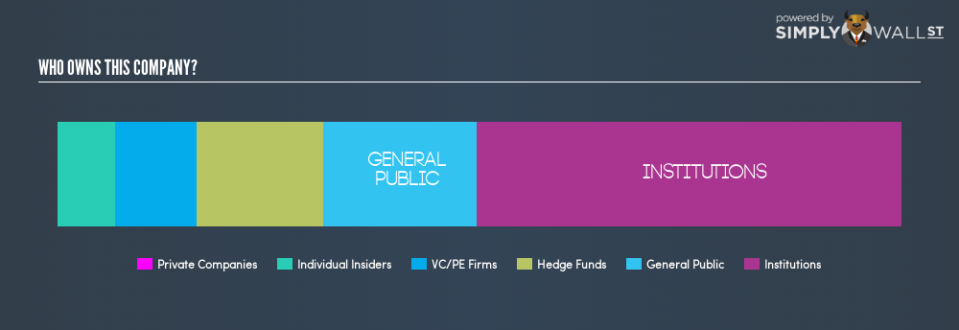Who Are The Major Shareholders In IFG Group plc (ISE:IJG)?

In this article, I will take a quick look at IFG Group plc’s (ISE:IJG) recent ownership structure – an unconventional investing subject, but an important one. The impact of a company’s ownership structure affects both its short- and long-term performance. The same amount of capital coming from an activist institution and a passive mutual fund has different implications on corporate governance, which is a decisive factor for a long-term investor. It also impacts the trading environment of company shares, which is more of a concern for short-term investors. Therefore, I will take a look at IJG’s shareholders in more detail.
Check out our latest analysis for IFG Group
Institutional Ownership
In IJG’s case, institutional ownership stands at 50.2%, significant enough to cause considerable price moves in the case of large institutional transactions, especially when there is a low level of public shares available on the market to trade. These moves, at least in the short-term, are generally observed in an institutional ownership mix comprising of active stock pickers, in particular levered hedge funds, which can cause large price swings. Considering hedge funds hold a stake of 15.0% in the company, IJG shares may experience high short-term volatility as this class of institutions are frequently found to sell significantly during market-wide shocks. I am going to further examine IJG’s ownership structure to check how other major shareholders can affect its investment case.
Insider Ownership
An important group of shareholders are company insiders. Insider ownership has to do more with how the company is managed and less to do with the direct impact of the magnitude of shares trading on the market. 6.9% ownership makes insiders an important shareholder group. This level of stake with insiders indicate highly aligned interests of shareholders and company executives. I will also like to check what insiders have been doing recently with their holdings. insider buying may be a sign of upbeat future expectations, however, selling doesn’t necessarily mean the opposite as insiders may be motivated by their personal financial needs.
General Public Ownership
A big stake of 18.2% in IJG is held by the general public. This level of ownership gives retail investors the power to sway key policy decisions such as board composition, executive compensation, and potential acquisitions. This is a positive sign for an investor who wants to be involved in key decision-making of the company.
Private Equity Ownership
With an ownership of 9.6%, private equity firms are a major stakeholder in IJG and are in a position to play an important role in shaping up corporate strategy with a focus on value creation. An investor should be encouraged by the ownership of these institutions who are known to be experts in increasing efficiency, improving capital structure and opting for value-accretive policy decisions.
Private Company Ownership
Another group of owners that a potential investor in IJG should consider are private companies, with a stake of 0.01%. While they invest more often due to strategic interests, an investment can also be driven by capital gains through share price appreciation. However, an ownership of this size may be relatively insignificant, meaning that these shareholders may not have the potential to influence IJG’s business strategy. Thus, investors not need worry too much about the consequences of these holdings.
Next Steps:
With significant institutional ownership, including active hedge, existing investors should seek a margin of safety when investing in IJG. This will allow an investor to reduce the impact of non-fundamental factors, such as volatile block trading impact on their portfolio value. However, if you are building an investment case for IJG, ownership structure alone should not dictate your decision to buy or sell the stock. Instead, you should be evaluating company-specific factors such as the intrinsic valuation, which is a key driver of IFG Group’s share price. I highly recommend you to complete your research by taking a look at the following:
Future Outlook: What are well-informed industry analysts predicting for IJG’s future growth? Take a look at our free research report of analyst consensus for IJG’s outlook.
Past Track Record: Has IJG been consistently performing well irrespective of the ups and downs in the market? Go into more detail in the past performance analysis and take a look at the free visual representations of IJG’s historicals for more clarity.
Other High-Performing Stocks: Are there other stocks that provide better prospects with proven track records? Explore our free list of these great stocks here.
NB: Figures in this article are calculated using data from the last twelve months, which refer to the 12-month period ending on the last date of the month the financial statement is dated. This may not be consistent with full year annual report figures.
To help readers see past the short term volatility of the financial market, we aim to bring you a long-term focused research analysis purely driven by fundamental data. Note that our analysis does not factor in the latest price-sensitive company announcements.
The author is an independent contributor and at the time of publication had no position in the stocks mentioned. For errors that warrant correction please contact the editor at editorial-team@simplywallst.com.

 Yahoo Finance
Yahoo Finance 
